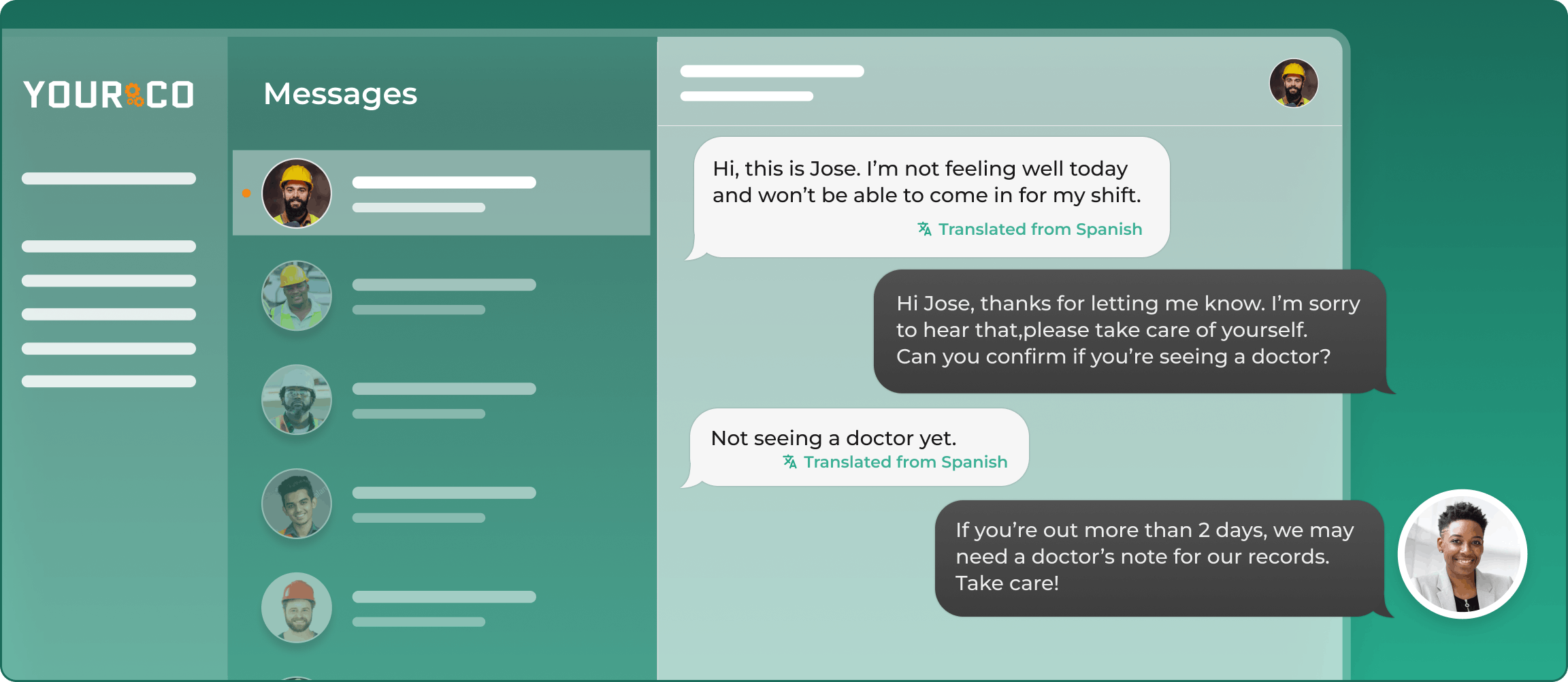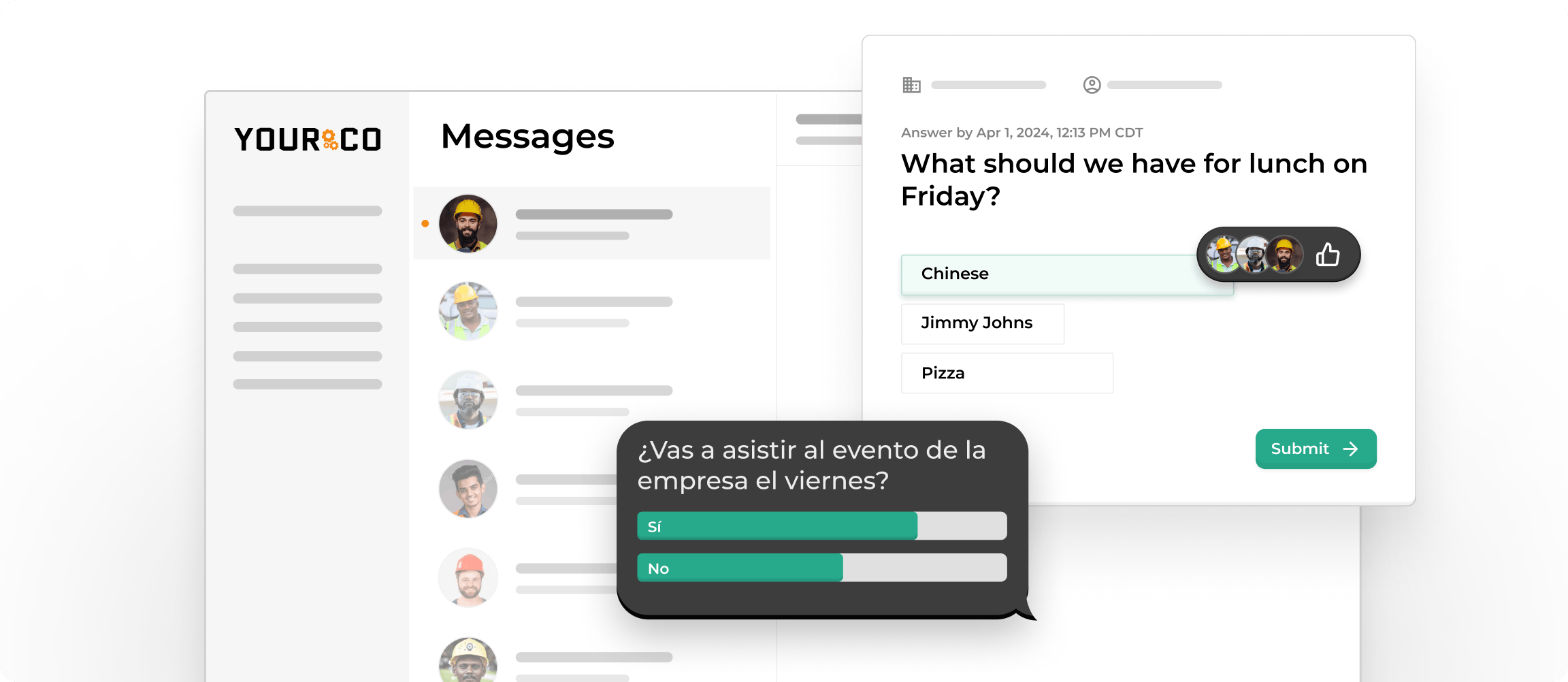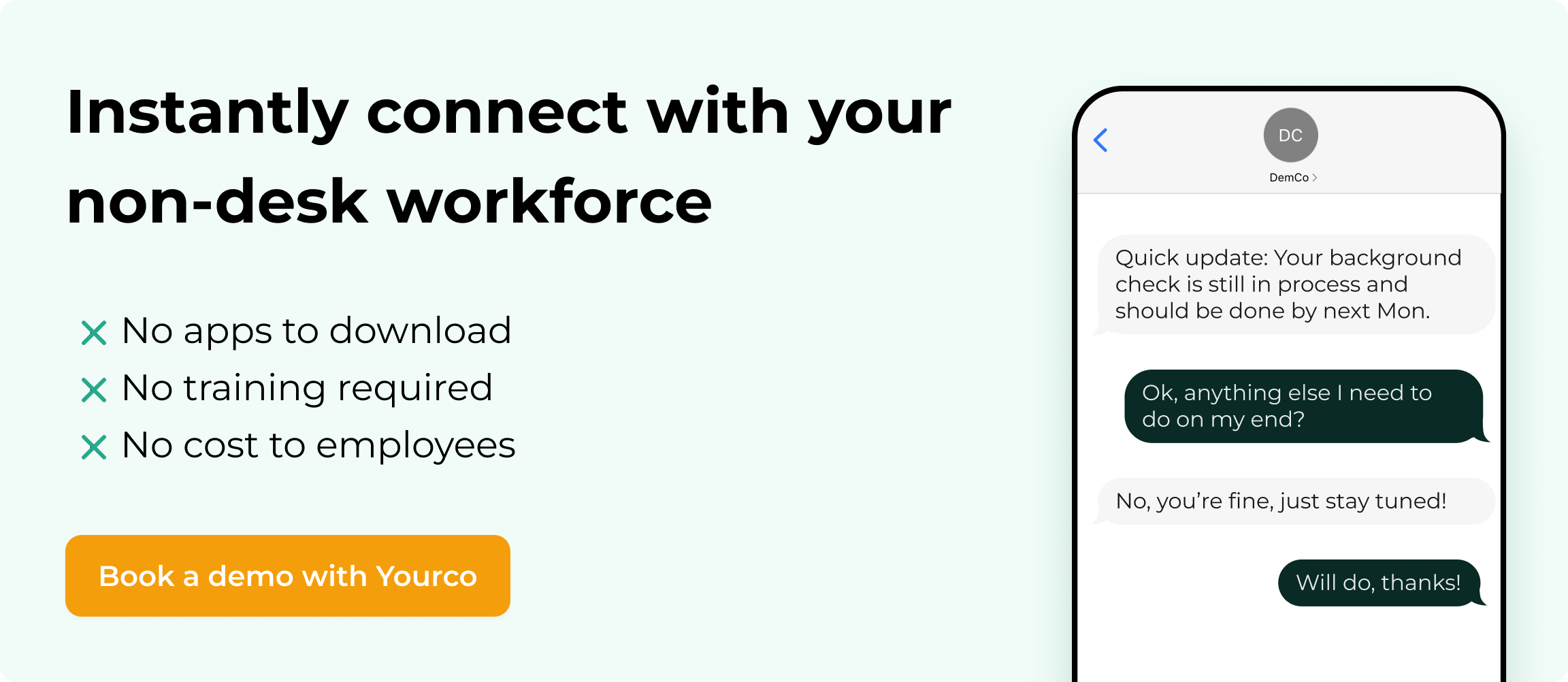Best Strategies to Engage Frontline Workers During Open Enrollment


Open enrollment is especially challenging when most of your workforce is on the floor, in the field, or on the line instead of behind a computer. Many frontline employees, who often never see company emails, make up the majority of the global workforce. When they miss deadlines or misunderstand their options, costs rise, coverage gaps appear, and frustration grows. Employers spend heavily on benefits, but too often those investments go unused because workers do not have the right information in time.
To avoid this, companies are turning to better employee benefits communication strategies that meet frontline teams where they are. This guide shows how to make enrollment smoother, raise participation, and help every employee make informed choices.
Know Your Frontline Workers' Communication Habits
Reaching frontline workers requires understanding how they differ from office-based staff. These employees rarely check company email, may lack regular computer access, and often work non-traditional hours when HR support isn't available. Different teams might have different communication preferences, and what works for one group may fail completely with another.
Start by conducting pulse surveys to ask employees how they prefer to receive benefits information, what time of day works best for important updates, and which communication barriers they've experienced in previous years. This feedback becomes the foundation for building targeted engagement strategies.
Language barriers present another challenge when reaching diverse frontline teams. Many manufacturing, construction, and service industry workers speak English as a second language, making clear, translated communications essential for comprehension. AI-powered translation tools can automatically convert enrollment messages into employees' preferred languages, eliminating comprehension barriers that prevent participation.
Timing matters just as much as language when connecting with your workforce. Frontline employees face unique scheduling challenges that differ significantly from office staff. Your teams may include night-shift nurses, weekend retail crews, and rotating manufacturing workers who need communications delivered when they're most likely to engage. Focus your outreach during times when team members are more likely to notice your message:
- Shift changes when workers naturally check their phones
- Break periods when employees have brief downtime
- Before shift start times, when teams gather for briefings
This strategic timing approach significantly improves response rates while reducing the need for multiple follow-up reminders.
Simplify Communication and Enrollment
Complex benefits information overwhelms employees regardless of their work environment, but frontline workers face additional barriers when trying to navigate enrollment on mobile devices during limited break times. Streamlining both your messaging and enrollment process removes these obstacles and makes participation accessible to everyone.
Use Mobile-Friendly Communication Channels
Text messaging delivers the immediacy and accessibility frontline workers need. SMS messages achieve 98% open rates compared to roughly 20% for email, ensuring critical enrollment information reaches employees. SMS works on any mobile phone, including basic models without internet access, making it truly universal for diverse workforces.
Craft text messages using clear, conversational language. Replace benefits jargon with plain English that makes sense during a quick phone check. Instead of "elect voluntary ancillary coverage," write "add vision or dental." Keep messages under 160 characters when possible, and include just one action employees can complete immediately.
Segment your messaging based on shift schedules, locations, and job roles to ensure relevance. A message about an on-site benefits fair in Chicago means nothing to warehouse workers in Phoenix. Similarly, night-shift employees need enrollment reminders sent during their work hours, not at 9 a.m. when they're sleeping.
→ Download our free Open Enrollment Communication Templates to support your team at every stage, starting with the initial announcement and continuing through ongoing updates. The templates make it simple for HR to save time, avoid misunderstandings, and keep employees well-informed.
Create Visual Learning Materials
Frontline workers often prefer visual explanations over dense text documents. Develop short videos, infographics, and simple comparison charts that employees can quickly review on their phones. A two-minute video explaining high-deductible health plans works better than a 10-page PDF that requires desktop viewing.
Make these resources mobile-optimized and accessible without logins or special apps. When you reference visual materials in text messages, ensure the links work seamlessly on any device and load quickly on cellular connections with limited bandwidth.
Streamline the Enrollment Process
Remove friction from the enrollment experience by implementing auto-enrollment for basic coverage and pre-populating forms with existing employee data. This approach helps workers who feel overwhelmed by multiple plan options or who have limited time to research every detail.
Offer multiple enrollment methods to accommodate different comfort levels with technology. While online portals work well for some employees, others prefer paper forms or brief phone consultations with benefits counselors. Having multiple pathways ensures no one gets excluded due to technology barriers or preferences.
Provide Multi-Channel Support and Education
Successful frontline engagement requires layering multiple communication touchpoints that reinforce key messages and provide various ways for employees to get help when they need it.
Establish SMS-Based Help Desks
Transform your text messaging channel into an always-available support resource by reserving keywords like "BENEFITS" that trigger automatic responses with helpful links, phone numbers, and FAQ resources. This approach gives frontline workers instant access to assistance, even during off-hours when traditional HR support isn't available.
Enable two-way SMS communication so employees can ask specific questions and receive personalized responses. This creates a conversational experience that feels more supportive than one-way broadcast messages, encouraging greater engagement throughout the enrollment period.
Use Peer Champions and Local Support
Identify respected employees across different shifts and locations who can serve as benefits champions within their teams. These peer advocates can answer basic questions during daily interactions, reducing the burden on HR staff while providing support in the language and style that resonates with frontline workers.
Train champions with simple talking points about the most important benefits changes, enrollment deadlines, and where to get additional help. A brief conversation during a shift change often proves more effective than formal presentations for reaching workers who are focused on their immediate tasks.
Schedule Live Support Sessions
Host benefits information sessions during shift changes, lunch breaks, and other times when frontline workers naturally gather. These sessions don't need to be formal presentations. Simple Q&A opportunities where employees can get immediate answers to their specific questions often work better.
For distributed workforces, consider phone-in sessions or brief video calls that accommodate workers who can't attend in-person meetings. Make these sessions optional and brief to respect employees' limited time, while ensuring multiple opportunities for engagement across different schedules.
Leverage Technology for Better Access
Modern communication platforms can bridge the gap between traditional HR processes and the realities of frontline work environments. Choose tools that enhance accessibility rather than creating additional barriers.
Implement Automated Translation Services
Language barriers significantly impact enrollment participation among diverse frontline teams. Modern SMS platforms like Yourco automatically translate enrollment messages into 135+ languages and dialects based on employee preferences stored in your HRIS system. This ensures every worker receives critical information in a language they understand, without requiring separate campaigns for different language groups.
Automatic translation capabilities extend beyond simple message conversion. They handle benefits terminology, compliance language, and even survey responses, creating a seamless multilingual experience that supports equitable access to benefits information.
Use Real-Time Surveys and Feedback Collection
Deploy quick SMS surveys throughout the enrollment period to identify confusion, gather feedback, and adjust your approach in real time. Simple one-question polls like "Choose 1 if you understand the new dental options, 2 if you need more info" help you identify who needs additional support before frustration builds.
This feedback loop proves especially valuable for frontline workers who don't voice concerns through traditional channels. Text-based surveys feel less formal and more approachable, encouraging honest feedback that improves your communication strategy.
Integrate with Existing HR Systems
Connect your communication platform with your HRIS to automatically update enrollment status, suppress reminders for completed applications, and trigger follow-up messages based on specific actions. This integration reduces administrative overhead while ensuring employees receive relevant information throughout the process.
Advanced integrations enable automatic enrollment confirmations, deadline reminders based on individual progress, and personalized next-step recommendations that guide each employee through their specific situation.
Build a Strategic Timeline and Follow-Up Plan
Successful frontline engagement requires careful timing that accounts for diverse work schedules, varying levels of benefits familiarity, and the natural tendency to delay non-urgent tasks.
Create a 60-Day Communication Calendar
Begin your enrollment campaign 60 days before the deadline with awareness-building messages that announce key dates and changes. This early start gives frontline workers time to consider their options without feeling rushed. For detailed guidance on this approach, see our complete guide on mastering open enrollment for multiple locations and diverse teams.
Structure your campaign with increasing urgency:
- 60 days out: Announce enrollment dates and major changes
- 30 days out: Highlight specific benefits that affect your workforce
- 14 days out: Address common questions and provide decision-support resources
- 7 days out: Send multilingual deadline reminders with direct enrollment links
- 24 hours out: Send final deadline alerts with completion confirmation requests
- Closing day: Thank participants and provide next-step information
This timeline ensures consistent awareness while respecting the reality that frontline workers often make important decisions closer to deadlines when urgency creates focus.
Monitor Progress and Adjust in Real Time
Track enrollment completion by location, shift, and demographic to identify groups that need additional support.
When you notice lagging participation in specific areas, deploy targeted interventions like additional local support sessions, peer champion outreach, or simplified enrollment options that remove specific barriers your data reveals.
Provide Post-Enrollment Support and Education
Engagement doesn't stop when enrollment closes. Continue communicating with newly enrolled employees to help them understand how to use their benefits effectively. This ongoing education prevents the underutilization that wastes employer benefit investments and leaves employees unprepared when they need coverage.
Send periodic reminders about preventive care options, wellness programs, and other benefits that require active participation to provide value. These touchpoints also serve as preparation for the next enrollment period, creating familiarity that improves future participation.
Measure Success and Build on Your Results
Tracking the right metrics proves your frontline engagement strategies are working and identifies areas for improvement in future enrollment periods.
Monitor Key Performance Indicators
Focus on metrics that reflect actual behavior change rather than just communication activity. Track key indicators that show real impact:
- Enrollment completion rates by demographic and location
- Time-to-completion after initial contact
- Support request volume and resolution speed
- Employee satisfaction scores with the enrollment process
Compare these metrics to previous years and benchmark against industry standards where available. Look for patterns that reveal which strategies work best for different segments of your workforce, then double down on successful approaches while refining less effective tactics.
Gather Employee Feedback
Deploy brief post-enrollment surveys to understand the employee experience from their perspective. Keep surveys to three questions or fewer and deliver them via text to maintain consistency with your enrollment communication approach.
Focus on actionable feedback that drives improvement:
- What made enrollment easier or harder this year?
- Which information sources were most helpful?
- What would improve the experience next year?
This qualitative data provides context for your quantitative metrics and guides strategic improvements.
Calculate Return on Investment
Document the business impact of improved frontline engagement by tracking reduced administrative overhead, decreased support ticket volume, and improved benefits utilization rates.
Present your findings to leadership with clear connections between engagement strategies and business outcomes. This documentation builds support for continued investment in frontline-focused communication tools and approaches.
Transform Enrollment Communication with Yourco
Effective frontline worker engagement during open enrollment requires more than good intentions. It demands the right tools and strategies working together seamlessly. Yourco's SMS-based employee communication platform addresses the core challenges that make traditional benefits communication ineffective for frontline workforces.
With 98% message open rates and AI-powered translations supporting 135+ languages and dialects, Yourco ensures your enrollment information reaches every employee in a format they can understand and act upon immediately. The platform's two-way communication capabilities let workers ask questions and receive personalized support, while automated workflows handle routine tasks like deadline reminders.
Yourco integrates with your existing HRIS systems to create a seamless experience that reduces administrative overhead while improving employee outcomes. Whether you're managing three locations or three hundred, the platform scales to meet your needs without adding complexity to your enrollment process.
Ready to transform your next open enrollment period? Try Yourco for free today or schedule a demo to see how the right communication strategy can turn enrollment challenges into competitive advantages.
Frequently Asked Questions
What's the most effective way to reach frontline workers?
SMS text messaging provides the best reach for frontline workers, achieving 98% open rates compared to 20% for email. Text messages work on any phone, including basic models without internet access, and reach employees immediately during their preferred communication times. Segment messages by shift schedule and location to ensure relevance and optimal timing.
How can I communicate benefits information to employees who speak different languages?
Use SMS platforms like Yourco, with AI-powered translation capabilities that automatically convert messages into employees' preferred languages. This approach eliminates the need for separate campaigns while ensuring accurate translation of benefits terminology. Store language preferences in your HRIS system to enable automatic message customization without manual intervention.
What's the best timing for sending enrollment reminders to different shifts?
Schedule messages to arrive when employees naturally check their phones: 7:15-8 a.m. for day shifts, 1:45-2 p.m. for afternoon crews, and 9:30-9:45 p.m. for evening workers. Avoid interrupting safety-critical tasks and always respect local time zones across multiple locations. Consider shift handoff periods when employees have brief availability.
How can I measure whether my frontline engagement strategies are working?
Track enrollment completion rates by location and demographic, monitor support request volumes, and measure time-to-completion after initial contact. Deploy brief SMS surveys after enrollment closes to gather employee feedback about their experience. Compare participation rates to previous years and calculate ROI based on reduced administrative overhead and improved benefits utilization.
Should I offer multiple enrollment methods for frontline workers with different technology comfort levels?
Yes, provide several enrollment pathways including online portals, paper forms, and phone consultations with benefits counselors. While SMS communication reaches everyone effectively, enrollment preferences vary based on individual comfort with technology. Multiple options ensure no employee gets excluded while maintaining efficiency through automated processes where appropriate.





